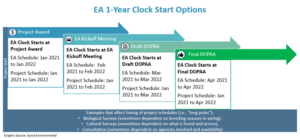When the National Environmental Policy Act (NEPA) regulations were overhauled in September 2020, one of the game-changing requirements was to define time limits to complete NEPA documents: one year to complete Environmental Assessments (EAs), and two years to complete Environmental Impact Statements (EISs).
You may know from personal experience that some NEPA documents have taken many years to complete. The Council on Environmental Quality’s (CEQ) is now attempting to help expedite the NEPA process and to remove the “bottlenecks” to proceed with federal projects, particularly time and funding-sensitive construction projects.
While the revised NEPA regulations specified when the EIS two-year clock starts, the regulations did not specify when the EA one-year clock starts. As a result, we have seen different interpretations when the EA clock should start. The following provides some of the differences we have seen amongst federal agencies and the pros/cons of each.
1. What do the regulations say?
The 2020 CEQ regulations state that EAs shall be completed within one year unless a senior official of the lead agency approves a longer period in writing and establishes a new time limit. This time limit aims to ensure timely decision-making.
Unlike the start of the clock for an EIS, which is triggered by the issuance of a notice of intent, the start of the clock for an EA is left much more open-ended. The CEQ regulations state that “one year is measured from the date of agency decision to prepare an environmental assessment to the publication of an environmental assessment or a finding of no significant impact.” Many agencies interpret the timing of their decision to prepare an EA differently.
2. Different agency interpretations.
The following graphic summarizes the different agency interpretations of when the EA one-year clock begins and below we detail the pros and cons.
 3. Clock start at award date or project kickoff.
3. Clock start at award date or project kickoff.
Some agencies take a literal interpretation of the one-year measurement laid out in the CEQ regulations. These agencies start the one-year clock at the time of the contract award for the EA. This interpretation has both pros and cons:
- Pros to starting the clock at award date or project kickoff:
Starting the one-year clock on the contract award date will always be clear and consistent across all projects. - Cons to starting the clock at award date or project kickoff:
Starting the one-year clock on the contract award date can lead to a very tight schedule for completing the EA, especially if biological or cultural surveys and/or regulatory consultations are necessary. It does not allow for much flexibility in the schedule if issues and/or setbacks arise.
4. Clock start at EA kickoff meeting.
Other agencies start the one-year clock at the EA kickoff meeting which some agencies define differently from the project kickoff meeting. Some agencies utilize the EA kickoff meeting to signify their decision to prepare an EA, thus starting the one-year clock.
- Pros to starting the clock at the EA kickoff meeting:
Starting the clock at the kickoff meeting provides for time to have preliminary discussions and workout preplanning items for the project. Completing these discussions prior to the start of the one-year clock allows for time-consuming issues to be handled in advance of the start of the clock so that they don’t eat up time in the schedule of the EA. - Cons to starting the clock at the EA kickoff meeting:
Often the exact specifics of the proposed action (e.g., location, acres, type of use, types and quantity of operations) are not fully determined at the time of the kickoff meeting. This can lead to changes in the proposed action down the road, which can lead to setbacks and delays in the EA schedule.
5. Clock start at Draft DOPAA submittal.
Some agencies choose to start the one-year clock when the Draft Description of the Proposed Action and Alternatives (DOPAA) is submitted. These agencies have determined that the draft submittal of the DOPAA signifies their decision to prepare an EA.
- Pros to starting the clock at the Draft DOPAA submittal:
Starting the clock at the Draft DOPAA submittal allows for the proposed action to be discussed and defined prior to starting the one-year clock. This helps to eliminate lengthy discussions of the details of the proposed action taking place within the short one-year EA timeline. - Cons to starting the clock at the Draft DOPAA submittal:
Sometimes there are substantial changes to the DOPAA between the draft and final submittals. Discussing and implementing these changes to the proposed action and alternatives can often take a long time. These discussions and changes at the beginning of the EA timeline can diminish leeway in the schedule further down the road if other issues arise.
6. Clock start at Final DOPAA approval.
Other agencies start the one-year clock with the agency approval of the Final DOPAA, or “stabilization” of the project description. This allows for the pre-planning for the project and the proposed action to be thoroughly flushed out prior to the start of the one-year timeline for the EA. Sometimes this can vary within federal agencies.
- Pros to starting the clock at the Final DOPAA approval:
Starting the clock at the Final DOPAA approval ensures that the proposed action is accurately defined and described prior to the start of the one-year clock. Hashing out the specifics of the proposed action can often be a lengthy and time-consuming process. Having a fully flushed out and approved DOPAA prior to the start of the one-year clock allows for flexibility in the schedule and ample time to complete other time costly and laborious tasks within the EA schedule (such as surveys and consultations). - Cons to starting the clock at the Final DOPAA approval:
It’s hard to see any cons to starting the clock at the Final DOPAA approval stage. Some agencies schedule the EA kickoff meeting to coincide with the Final DOPAA approval. One advisory note is if agencies start the clock at the Final DOPAA approval stage, you may want to consider tying the DOPAA development process with incorporation of any key biological or cultural surveys. For example, some surveys such as migratory bird surveys can only be conducted during certain times of the year due to breeding seasons, so the schedule should factor in these critical paths.
We hope this gives you a quick snapshot of what different agencies are doing to help you streamline your NEPA process. The biggest takeaway is that if CEQ requests reports from federal agencies about their statistics of meeting the one-year EA completion mark, those statistics may be skewed as they are defined and implemented differently amongst federal agencies.
Contact us today to help you with completing your EAs on time: melanie.hernandez@scoutenv.com.




 3. Clock start at award date or project kickoff.
3. Clock start at award date or project kickoff.













